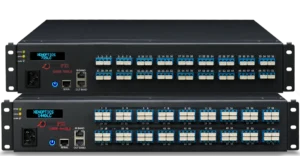Markets don’t pause for a patch cord. In exchange colos, cages stay hands-off during trading hours and every physical change demands clearance and a maintenance window. A smart optical switch (CSOS) turns those constraints into software—so you govern Layer 0 with the same rigor you apply at Layers 3–7.
Why Finance Needs Layer 0 Controls
You encrypt, segment, and monitor at higher layers, yet the physical plant often remains manual. That gap creates three risks: delayed recovery (you can’t touch fibers when the bell rings), unauthorized changes (a “helpful” move that breaks a cross-connect), and weak audit trails. Bringing Layer 0 into your control plane closes the loop with zero-touch workflows and immutable logs.
What CSOS Does in an Exchange Colo
 CSOS replaces manual patch panels with remote fiber management. You wire once, then execute moves/adds/changes via GUI or API—no hands in the rack. Each robotic cross-connect completes in about 36–60 seconds and is passively latched to keep light paths up through power events. Standby draw is only ~6 W (deep sleep ≤0.5 W), so you can leave systems armed for post-close windows without a power penalty.
CSOS replaces manual patch panels with remote fiber management. You wire once, then execute moves/adds/changes via GUI or API—no hands in the rack. Each robotic cross-connect completes in about 36–60 seconds and is passively latched to keep light paths up through power events. Standby draw is only ~6 W (deep sleep ≤0.5 W), so you can leave systems armed for post-close windows without a power penalty.
- Any-to-any, non-blocking switching in compact 72/144-port models suited to top-of-rack and edge cages.
- Passive latching means established connections stay up even if mains or UPS blip. No packet loss while you service modules.
- Exchange-friendly density: CSOS architecture scales to 10k+ fibers per rack when aggregated, minimizing colo footprint for cross-connect zones.
- Outside-plant hardening options (–40 °C to +65 °C) for street-level POPs feeding colos.
Security and Audit, Aligned with Zero-Trust
Treat every strand as untrusted. Make every action explicit, approved, and logged.
- Packet-blind optics. CSOS switches light without parsing frames, MACs, or VLANs—shrinking the attack surface at Layer 0.
- Strong identity & RBAC. NMS supports local and remote authentication (LDAP/RADIUS/TACACS+), role scoping, and customer tenancy.
- Change queues & four-eyes. Queue connections for after-hours execution; require dual approval per policy and keep a full, time-stamped activity log.
- Immutable evidence. Every connect/disconnect is recorded for audit and SIEM ingestion.
These controls extend your zero-trust posture down to fiber, matching guidance to “never trust, always verify” at the physical layer.
Built for Low-Latency Operations
Trading networks are allergic to inline electronics. CSOS honors that:
- Low optical penalty. Field values: insertion loss ≤ 1.0 dB in the standard connectorized configuration; return loss < -55 dB (UPC).
- No packet processing. The switch introduces no buffering, parsing, or protocol awareness—keeping latency consistent and predictable.
- Power-independent continuity. Latching keeps established paths up if a PSU is serviced or a rack loses power.

How Teams Actually Use It
- Before the bell. Queue a cross-connect plan (e.g., failover from a congested path or a carrier turn-up). The NMS computes shortest paths, validates port availability, and stages tasks.
- After close. Trigger the batch. Each switch action executes in seconds, with live status and cameras available for oversight. If a change slips, leave it queued until the next window—no stranded tech time.
- Audit Monday. Export logs of who did what, when, and where, tied back to identities and tickets.
Patterns That Fit Trading Floors
- Cage cross-connect hub. Drop a CSOS in your MMR/cage to broker any-to-any between carriers, PTP, and internal leaf/spine without touching cords during market hours. (This mirrors MDF/MMR patterns we’ve proposed in bank/data-center builds with phased rollouts.)
- Edge POPs. Use OSP-rated CSOS at street cabinets or metro POPs to pre-stage reroutes for fiber incidents—then swing traffic after hours.
- Scale-up path. Where you need massive fan-out, pair CSOS domains with larger matrices (e.g., XSOS) to reach thousands of ports per rack without expanding patch fields.
Ops and Compliance Wins
- Speed: Switch a physical path in ~36–60 s instead of scheduling hands and risking fat-finger errors.
- Risk reduction: Remove routine human touches; enforce approvals; keep immutable logs.
- Cost control: Fewer after-hours truck rolls and escorts; per-port economics comparable to manual ODFs; typical ROI 12–18 months at scale.
- Energy: Passive latching draws power only during switching; ~6 W idle helps with Scope-2/3 reporting.
From Concept to Pilot
Map one cage or POP as a pilot. Define a post-close change window and a four-eyes policy in NMS. Wire once, then automate MACs from your runbooks. We’ll help you set guardrails that satisfy both the desk and audit.

